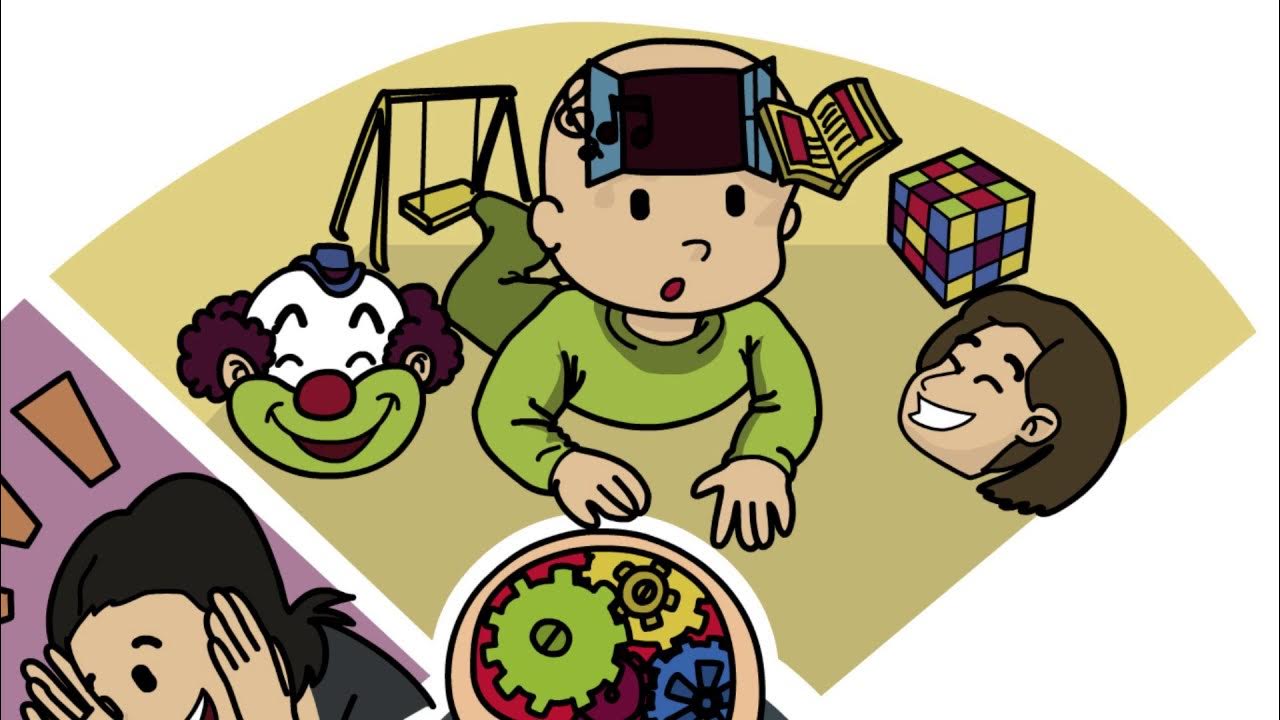Physical Development In Early Childhood
Summary
TLDRThis video script explores physical and cognitive development in early childhood, focusing on the growth of the skeleton, brain, and motor skills. It explains the gradual physical changes, such as improved posture, balance, and the loss of baby fat. Key developments in the brain, including synaptic pruning, lateralization, and the growth of essential areas like the cerebellum and hippocampus, are discussed. Additionally, the script covers the influence of heredity, hormones, nutrition, and immunization on health and growth. It also addresses motor skills development, including fine motor skills, self-help abilities, and individual differences in development.
Takeaways
- 😀 Growth in early childhood sees a slowdown compared to infancy and toddlerhood, with children becoming thinner and improving posture and balance.
- 😀 Between ages 2-6, about 45 new epiphyses form in the skeleton, contributing to the hardening of cartilage into bone, and children begin to lose their primary teeth.
- 😀 Brain development during early childhood involves an increase in brain weight to 90% of adult size, with improvements in coordination, memory, language, and logical thinking.
- 😀 Synaptic pruning occurs as unused neurons lose their connective fibers, leading to more efficient brain functioning in areas such as perception and attention.
- 😀 The left hemisphere is primarily responsible for language skills, especially active between ages 3-6, while the right hemisphere focuses on spatial skills.
- 😀 Handedness is influenced by the brain’s lateralization, with right-handed people typically having language housed in the left hemisphere and left-handed individuals having more shared lateralization across hemispheres.
- 😀 The cerebellum, involved in motor control, becomes myelinated, which enhances motor skills and coordination.
- 😀 Early childhood nutrition is essential for growth, with children needing a high-quality diet despite their declining appetites. Poor diet and lack of access to proper food can hinder development.
- 😀 Infectious diseases and malnutrition have a two-way interaction, where poor nutrition weakens immunity, making children more prone to disease, which further disrupts development.
- 😀 Injuries, especially unintentional ones, are the leading cause of childhood death in industrialized nations. Preventive measures include public awareness and family-level interventions to reduce hazards.
- 😀 Motor development in early childhood includes the improvement of both gross and fine motor skills, such as running, jumping, and drawing, with differences in motor skills between boys and girls based on biological and cultural influences.
Q & A
What happens to body growth during early childhood compared to infancy and toddlerhood?
-Body growth starts to slow down in early childhood compared to infancy and toddlerhood. Children gradually become thinner as they lose some of their baby fat.
How does skeletal growth occur between the ages of 2 and 6?
-Between ages 2 and 6, approximately 45 new epiphyses, or growth centers, emerge in various parts of the skeleton. These areas, where cartilage hardens into bone, contribute to the development of the child's skeleton.
What is synaptic pruning, and why does it occur during early childhood?
-Synaptic pruning is the process in which neurons that are seldom used lose their connective fibers. This occurs because the brain has overproduced synapses by age 4, and synaptic pruning helps refine neural connections, making the brain more efficient.
What are the key developments in the brain between ages 2 and 6?
-The brain increases from 70% to 90% of its adult weight, and several areas of development occur, including improved physical coordination, memory, perception, attention, language, and logical thinking.
What factors influence handedness in early childhood?
-Handedness can be influenced by a child's position in the uterus, opportunities to practice using both hands, and cultural factors. In right-handed individuals, language is typically housed in the left hemisphere of the brain.
How do the left and right hemispheres of the brain contribute to early childhood development?
-The left hemisphere is active between ages 3 and 6, primarily responsible for language skills, while the right hemisphere, which is involved in spatial skills, becomes more active throughout early and middle childhood.
What role does the cerebellum play in motor development during early childhood?
-The cerebellum plays a critical role in balance and motor control. Its development helps children improve their motor skills, as the fibers linking it to the cerebral cortex continue to grow and become myelinated during early childhood.
What impact do hormones have on physical growth in early childhood?
-Hormones such as growth hormone and thyroid stimulating hormone influence body growth. The pituitary gland releases these hormones, which are essential for the development of body tissues, brain development, and overall physical growth.
What are the consequences of inadequate nutrition during early childhood?
-Inadequate nutrition can depress the immune system, increasing the likelihood of contracting diseases. Additionally, poor nutrition can hinder both physical and cognitive development, creating a cycle where disease worsens malnutrition.
How does fine motor skill development progress in early childhood?
-Fine motor skills in early childhood include self-help skills such as dressing and feeding themselves. By age 6, children may develop the ability to tie their shoes, and their drawing and writing skills become more complex and refined.
Outlines

هذا القسم متوفر فقط للمشتركين. يرجى الترقية للوصول إلى هذه الميزة.
قم بالترقية الآنMindmap

هذا القسم متوفر فقط للمشتركين. يرجى الترقية للوصول إلى هذه الميزة.
قم بالترقية الآنKeywords

هذا القسم متوفر فقط للمشتركين. يرجى الترقية للوصول إلى هذه الميزة.
قم بالترقية الآنHighlights

هذا القسم متوفر فقط للمشتركين. يرجى الترقية للوصول إلى هذه الميزة.
قم بالترقية الآنTranscripts

هذا القسم متوفر فقط للمشتركين. يرجى الترقية للوصول إلى هذه الميزة.
قم بالترقية الآنتصفح المزيد من مقاطع الفيديو ذات الصلة
5.0 / 5 (0 votes)






